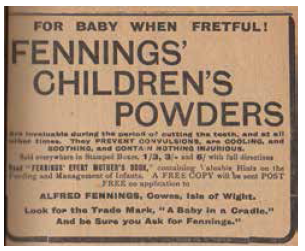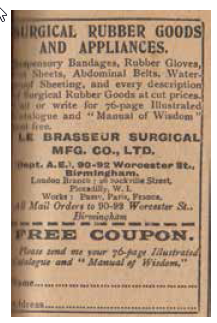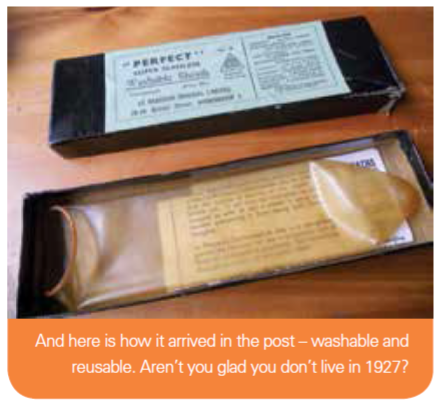Old advertisements from a bygone Irish era are worth dissecting. And that’s what we are going to do here!
By Nicole Buckler
Old Moore’s Almanac has been around for a very long time. We have copies dating back 100 years, and there are copies hundreds of years older than that in the National Library of Ireland. These old tomes give us a hilarious insight into the advertising industry back then.
It was a golden time for advertisers simply because you could say anything about your product. Vendors didn’t have to prove a damn thing that they claimed. And it seems the Almanac was more than happy to carry all sorts of dodgy advertisements. Ahhh money, so nice.
Today, we’ll take you back to our 1927 edition of the Old Moore’s Almanac, when telephones were just appearing and oily hair was a serious danger to polite society.
Ireland in 1927
1927 in Ireland was a time between wars and strife. The country was only a few years into running itself as a sovereign state. While the Irish people struggled to establish themselves, the outside world was in a bit of a stickier situation. Scuffles were all around, and in the absence of outright war, there were plenty of threats of war.
At this time, there were a few firsts in Ireland:
- Celtic Park in Belfast was opened – the first greyhound track in Ireland.
- Ireland’s first automatic telephone exchange is opened in Dublin.
- Ernest Bewley opens his Grafton Street café in Dublin.
While Irish political life was still turbulent, events happening across the world provided distraction. Americans transmit the first experimental electronic television pictures, as opposed to mechanical TV systems that others had tried before. It was a brilliant success. And, the world’s population reached two billion. Unfortunately however, in Britain, one thousand people a week were still dying from an influenza epidemic.
Old Advertisements: A Cure for Neurasthenia


Old advertisements from the 1927 Old Moore’s Almanac.
This ad appears early in the 1927 edition, offering a cure for Neurasthenia. So what the bejapers is that I hear you cry? And can I catch it? Neurasthenia is a term that was first used at least as early as 1829 to label a sickness thought to affect the nervous system. Strangely, Americans were said to be particularly prone to neurasthenia, which resulted in the term “Americanitis.” But Irish people were no strangers to it, either.
At the start of the 20th century, life was changing very fast for the American people, in much the same way as it is in China today. People were moving from rural areas into cities, and this caused a rapid change in daily life.
People went from being farmers, growing their own foods, and living by the seasons, to working in an industrial economy. They lived and worked indoors, ate food out of cans and packets, and the seasons had nothing to do with their daily lives. They had more income than ever before but competitive consumerism as a life sport had begun and it was stressing them out. New technology was everywhere, and life was moving at a very fast pace.
This transition wasn’t an easy slide into modern life for everyone. Many people found it a bit too much for them, and thus ended up at the doctor’s surgery with a list of complaints including fatigue, depression, insomnia, weakness, the jitters and headaches. Some people found their new life utterly overwhelming. Typically, the illness was associated with upper class people and with professionals working in sedentary occupations.
Cures
There were three “cures” deemed worthwhile at the time. One was bed rest, which all of us would love these days. The next cure was to use a potion. To capitalise on the epidemic, the Rexall drug company introduced a medication called ‘Americanitis Elixir’ which claimed to be a soother for any bouts related to Neurasthenia. Of course, it was probably made of opium, which found itself to be quite the popular remedy at the time.
However there was a third cure. And an ad for it appeared in the Old Moore’s Almanac of 1927…whereby some “medical people” would come to your house and do strange things to you with electricity. Electrotherapy was thought of as a normal route to wellness at this time. The cure, however sounded worse than the original illness. In reality, if you were suffering from Neurasthenia, you were hooked up to a socket and shocked.
In the end the condition Neurasthenia faded out of public conversation or the symptoms were reclassified as other illnesses. These days, Neurasthenia has largely been abandoned as a medical diagnosis; however the term is still used in Asia, and particularly in China where interesting parallels can be drawn to 1920s America.
Old Advertisements: Fenning Children’s Powders


Old advertisements from the 1927 Old Moore’s Almanac.
Found on page 21 of the 1927 edition of Old Moore’s Almanac, this advertisement was very much par for the course in 1927. Believe it or not, these “cooling powders” are still around today, although the list of ingredients has morphed over time. The original formula evolved from a recipe made up of some highly suspect ingredients. Now it has a more reliable list of ingredients with the right kind of scientific investigation supporting them.
Fennings’ Children’s Powders were given to babies who were cutting their first teeth. And anyone with a teething child knows just how many sleepless nights you can clock up while those pesky milk teeth grow through those gums. While teething these days is seen as an annoyance, this was not the case way back when. Historical attitudes to teething ranged from hilarious to downright insanity.
For centuries people believed that the teething process caused many childhood illnesses and even death in infants. Until the 20th century the death rate among infants and small children was high, coincidentally most deaths took place during the time of teething.
Doctors came to the conclusion that teething was a highly dangerous business. So they indulged in barbaric practices to “help” teeth come through. One method was called “blistering”. In historical medicine, blistering was undertaken using a caustic substance on the problem areas to induce a burn or blister. The goal was to create infection as physicians of the day thought that the subsequent puss draining from the wound would be beneficial for the patient. The milk tooth was then expected to grow through the gums much more easily.
Teething
Then there was the method of bleeding to tackle teething – where leeches were applied to the area of the gums to help the tooth come through. And then there was lancing, which is a horror show. This is a process whereby the baby’s gums were sliced down to the erupting tooth with a lancet, to make a “pathway” for the tooth to come through. This was done without pain relief and probably with dirty instruments. The Medical Journal of 1857 recommends that, “A superficial incision will be of no avail; the gums must be cut down until the lancet impinges on the approaching tooth”. It seems ridiculous beyond measure these days. Mercifully, lancing was out of fashion by the 1920s, so new remedies were sought.
As new teething solutions were brought to the market, the most worrying thing about the process was that there was no regulation as to what ingredients manufactures used to make these remedies. Manufacturers weren’t even required to put an ingredients list on the packaging. So they lost the run of themselves.
Early medicines used to treat teething often contained opium, due to its ability to relieve pain and induce sleep. The opium was called “syrup of white poppies” and was a trusted remedy. Other suspicious ingredients in teething powders of the time included alcohol, and mercury-based compounds such as calomel. Mothers were unaware of the mercury in these remedies and much controversy followed when the ingredients were revealed at a later date. Some babies had been given these “powders” over a long period of time, and we all know how mercury and humans don’t mix.
Syrup
Mercury wasn’t the only suspicious ingredient. One product, called Mrs Winslow’s Soothing Syrup, was marred by controversy and court cases, because initially it contained morphine – and lots of it. Mothers were unaware of the morphine content. From the late 1860s up until the early 20th century, there were numerous cases of American babies falling into a coma or becoming addicted to the syrup. Some even died. Morphine was not completely removed from Winslow’s Soothing Syrup formula until 1909. Imagine!
Fennings’ Children’s Cooling Powders was in fact one of the powders with the least controversy. This is probably why it survives a product today. In fact it is preferred today by some parents over similar products like Calpol, because the product is just a paracetamol powder with no sugar or colourings added. Parents just dissolve it in water and give it to the baby. And then hopefully everyone gets a good night’s rest.
The creator of Fennings’ Cooling Powders was not without controversy himself. Alfred Fennings opened his first shop in 1840 – the Golden Key Pharmacy in Hammersmith Broadway, London. Fennings sold medicines for the treatment of typhoid and cholera as well as for more minor ailments such as coughs and colds. In 1850 the business moved to Cowes, Isle of Wight and went into manufacturing.
Highly adept at advertising and marketing, Fennings went on to create a very successful business. He wrote a book called Every Mother’s Handbook, which today would be considered a conflict of interest and definitely a type of blatant advertorial for his products. It was probably a tome of misinformation and scarily inaccurate advice. Thank God for modern day-science.
But back then, the industry had no regulation so it is safe to say that sometimes the cure really was worse than the illness. Upon the death of Alfred Fennings, trustees took over the running of the business and the profits went to a children’s charity. Fennings’ company only ceased trading in 1996, so this guy is still very much a relevant figure of our time.
Old Advertisements: LeBrasseur Surgical


Old advertisements from the 1927 Old Moore’s Almanac.
This advertisement, on page 78 of the 1927 edition, is difficult to interpret as seen through the eyeballs of someone living in 2013. The text states that if you are a wise lady, then you will write to Le Brasseur Surgical for the “Triumph Treatment” for all irregularities.
While initially, that sounds like a constipation cure, it was actually an ad for something completely different. It was a 1927 euphemism that had nothing to do with keeping you regular. It was actually an ad for condoms! Well, what they called condoms in those days. They are certainly not condoms as we know them now…phew… thank the Gods for living in 2013.
A lot of advertisements in this era couldn’t say outright what they were selling, due to the products being illegal or socially unacceptable. The advertisement, instead of bellowing on about condoms, asked readers to write away for the information booklet.
Seeing as it was free to write away, Irish ladies would indeed put fountain pen to paper. What they got back was a book called A Guide for Husbands and Wives: A Manual of Wisdom, authored by Douglas Neale of LeBrasseur Surgical Manufacturing Co. Amazingly, the book is available as a print-on-demand publication through google books. You can just imagine the treasure trove of misinformation and blatant advertorial it contains. It is next on your Goodreads list for sure.
It is safe to assume that it was intended as a guide to safe sex and contained details about how to use the condoms. Such condoms of the day were made from rubber the same thickness as a bicycle inner tube. At the time, condoms were so thick and strong that they were …REUSABLE! The condoms of 1927 didn’t enhance pleasure but it did the main job of averting pregnancy and protecting against sexual diseases, which were big problems at the time.
Alternative phrasing
The reason why so many “alternative” phrases needed to be used in old advertisements, especially in an Irish publication of 1927 was that the Catholic Church wasn’t budging on its opinion of contraception. Not so with other religions who were relaxing on the condom front. By 1930 the Anglican Church sanctioned the use of birth control by married couples. In 1931 the Federal Council of Churches in the U.S. issued a similar statement.
However, the Roman Catholic Church responded by affirming its opposition to all contraceptives, a stance that has never changed, even to this day. So using condoms in 1927 Ireland was very much something you did on the down-low. These old advertisements pretty much display just how quiet you had to be about your plans to not have 25 children.


Despite what some community leaders would have liked, the market for condoms at this time was growing rapidly and their quality was improving fast due to advances in the rubber manufacturing process. Throughout Europe and Russia, they were sold at pubs, barbershops, chemist shops, open-air markets, and at the theatre. Their use later spread to America. Ireland was however still behind on condom freedom. But some women who were “wise” and ordered them via Old Moore’s Almanac were covered.
Social Advice From the Late 1920s
As we know the Almanac has provided readers with lots of different and varied information over the years. Old advertisements are just one gem. There are others: This article is an excellent gauge on what was acceptable and what wasn’t in polite Irish society. Advice includes:
“Do not spare on soap, for people comment on dirty nails, eyes or ears.”
Well this one is obvious. We still have this advice today – don’t be a minging soap dodger. The end.
“Don’t dress above your station or means, or kind neighbours will make nasty innuendoes.”
Since when did kind people act nasty? Now we are told to dress like the position you want to hold. So if you want to eventually be the boss, dress like the boss. Seeing as Mark Zuckerberg is currently the boss, we can relax in the knowledge that we can wear corduroy pants and trainers to work and maybe even just our underpants if we feel a little hot.
“Don’t monopolise the best-looking girl at the party. Remember the plainer ones are in the majority and can talk.”
This sounds suspiciously like it was written by someone a bit beaten with the ol’ ugly stick. Beautiful people can be just as interesting as those who dress above their station.
“Don’t lean your oily head against the wallpaper or on the back of the best chair, it will make your host nervy.”
If ANYONE in this day and age had hair oily enough to leave a giant smear anywhere in public, then they shouldn’t have left their house in the first place. Get back inside.
It was hard work being perfect in 1927. However these old advertisements were a fascinating look into the thinking of the day.
You can browse back editions of the Old Moore’s Almanac by going into the National Library of Ireland. You can’t borrow them however, you must read them in the library. If you’re really intrigued about these old issues of the Almanac, allow us to take you on a tour of the 1914 edition or the 1933 edition.





